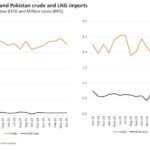By T N Ashok
NEW YORK: The escalating conflict between India and Pakistan is offering the world a glimpse of how Chinese military hardware is scaling up against western military hardware including from ground to air power as China has been the main supplier of military equipment to Pakistan whereas India outsources its military equipment from Russia and the West including USA, UK and France.
The world is getting a first real glimpse into how advanced Chinese military technology matches against proven Western hardware – and Chinese defense stocks are already surging.
Shares of China’s AVIC Chengdu Aircraft rose 40% this week, as Pakistan claimed it used AVIC-produced J-10C fighter jets to shoot down Indian combat aircraft – including the advanced French-made Rafale – during an aerial battle on Wednesday.
India has not responded to Pakistan’s claims or acknowledged any aircraft losses. When asked about the involvement of Chinese-made jets, a spokesperson for China’s Foreign Ministry said on Thursday he was not familiar with the situation.
Still, as Pakistan’s primary arms supplier, China is likely watching intently to find out how its weapon systems have and potentially will perform in real combat. A rising military superpower, China hasn’t fought a major war in more than four decades. But under leader Xi Jinping, it has raced to modernize its armed forces, pouring resources into developing sophisticated weaponry and cutting-edge technologies, media reports said.
China has also extended that modernization drive into Pakistan, long hailed by Beijing as its “ironclad brother.” Over the past five years, China has supplied 81% of Pakistan’s imported weapons, according to data from the Stockholm International Peace Research Institute (SIPRI).
Those exports include advanced fighter jets, missiles, radars and air-defense systems that experts say would play a pivotal role in any military conflict between Pakistan and India. Some Pakistan-made weapons have also been co-developed with Chinese firms or built with Chinese technology and expertise.
“This makes any engagement between India and Pakistan a de facto test environment for Chinese military exports,” said Sajjan Gohel, international security director at the Asia-Pacific Foundation, a think tank based in London.
Chinese and Pakistani militaries have also engaged in increasingly sophisticated joint air, sea and land exercises, including combat simulations and even crew-swapping drills.
“Beijing’s long-standing support for Islamabad – through hardware, training, and now increasingly AI-enabled targeting – has quietly shifted the tactical balance,” said Craig Singleton, a senior fellow at the US-based Foundation for Defense of Democracies.
“This isn’t just a bilateral clash anymore; it’s a glimpse of how Chinese defense exports are reshaping regional deterrence.”
That shift – brought into sharp focus by rising tensions between India and Pakistan following a tourist massacre in Kashmir – underscores a broader geopolitical realignment in the region, where China has emerged as a major challenge to American influence.
India espouses the policy of nonalignment and was in the forefront of the nonaligned movement during the cold war. Despite this, India has drawn ever closer to the US, as successive American administrations courted the rising South Asian giant as a strategic counterweight to China.
India has ramped up arms purchases from America and its allies, including France and Israel, while steadily reducing its reliance on Russian weaponry.
Meanwhile, Pakistan has strengthened its ties with China, becoming its “all-weather strategic partner” and a key participant in Xi’s signature global infrastructure project, the Belt and Road Initiative. According to SIPRI’s data, the US and China each supplied about one-third of Pakistan’s imported weapons in the late 2000s. But Pakistan has stopped buying American arms in recent years and increasingly filled its arsenal with Chinese weapons.
In Pakistan, the ruling government has no control either over the army or the intelligence wing ISI. The ISI has been accused of fomenting trouble across the LoC sending armed insurgents to engage in random suicide bombing and hitting Indian army posts.
China has expressed regret over India’s military strikes against Pakistan and has called for calm and restraint. Before the latest escalation, Chinese Foreign Minister Wang Yi expressed support for Pakistan in a phone call with his counterpart, calling China Pakistan’s “ironclad friend.”
Many analysts believe the missiles and other munitions were fired by India’s French-made Rafale and Russian-made Su-30 fighter jets. Pakistan, meanwhile, touted a great victory by its air force, claiming that five Indian fighter jets – three Rafales, a MiG-29 and a Su-30 fighter – were shot down by its J-10C fighters during an hour-long battle it claimed was fought by 125 aircraft at ranges over 160 kilometres.
“(It) is now being characterized as the most intense air-to-air combat engagement between two nuclear-armed nations,” said Salman Ali Bettani, an international relations scholar at Quaid-i-Azam University in Islamabad. “The engagement represented a milestone in the operational use of advanced Chinese-origin systems.”
Shares of China’s state-owned AVIC Chengdu Aircraft, the maker of Pakistan’s J-10C fighter jets, closed 17% higher on the Shenzhen exchange on Wednesday, even before Pakistan’s foreign minister claimed the jets had been used to shoot down India’s planes. Shares in the company rose an additional 20% on Thursday.
The J-10C is the latest version of China’s single-engine, multirole J-10 fighter, which entered service with the Chinese air force in the early 2000s. Featuring better weapon systems and avionics, the J-10C is classified as a 4.5-generation fighter – in the same tier as the Rafale but a rung below 5th-generation stealth jets, like China’s J-20 or the US F-35.
China delivered the first batch of the J-10CE – the export version – to Pakistan in 2022, state broadcaster CCTV reported at the time. It’s now the most advanced fighter jet in Pakistan’s arsenal, alongside the JF-17 Block III, a 4.5-generation lightweight fighter co-developed by Pakistan and China.
The Pakistan Air Force (PAF) also operates a larger fleet of American-built F-16s, one of which was used to shoot down a Soviet-designed Indian fighter jet during a flare-up in 2019.
But the PAF’s F-16s are still stuck in an early-2000s configuration – far behind the upgraded versions currently offered by the US – while the Chinese-made J-10CEs and JF-17 Block IIIs feature contemporary technologies such as active electronically scanned array (AESA) radars, Khan said.
“So, the F-16s are still a major piece to any PAF-led reprisal, but not the central or indispensable one,” he said. Senior Col. (ret) Zhou Bo, senior fellow at Tsinghua University’s Center for International Security and Strategy in Beijing, said if Chinese-made J-10Cs were indeed used to shoot down the French-made Rafales, it would be “a tremendous boost of confidence in Chinese weapon systems.”
Zhou said it would “really raise people’s eyebrows” particularly given China has not fought a war for more than four decades. “It will potentially be a huge boost for Chinese arm sales in the international market,” he said.
The Pakistan Air Force (PAF) also operates a larger fleet of American-built F-16s, one of which was used to shoot down a Soviet-designed Indian fighter jet during a flare-up in 2019.
But the PAF’s F-16s are still stuck in an early-2000s configuration – far behind the upgraded versions currently offered by the US – while the Chinese-made J-10CEs and JF-17 Block IIIs feature contemporary technologies such as active electronically scanned array (AESA) radars, Khan said.
“So, the F-16s are still a major piece to any PAF-led reprisal, but not the central or indispensable one,” he said. Senior Col. (ret) Zhou Bo, senior fellow at Tsinghua University’s Center for International Security and Strategy in Beijing, said if Chinese-made J-10Cs were indeed used to shoot down the French-made Rafales, it would be “a tremendous boost of confidence in Chinese weapon systems.”
The India-Pakistan confrontation seems to be tuning into a full scale air war as both the Indian and Pakistani forces fired long range missiles directed at the respective army bases. Pakistan will be using more and more Chinese weapons while India will be using a mix of Russian, American, French and British weapons. Both the Chinese and the American arms manufacturers are monitoring closely at the success of the respective weapons in the current India- Pakistan war. (IPA Service)



 Conflict With India Seriously Endangers Pakistan’s Energy Security
Conflict With India Seriously Endangers Pakistan’s Energy Security 